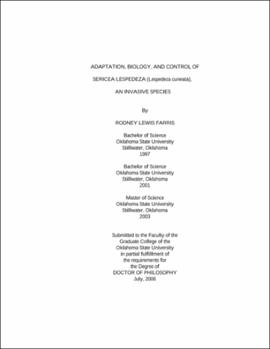| dc.contributor.advisor | Murray, Don S. | |
| dc.contributor.author | Farris, Rodney Lewis | |
| dc.date.accessioned | 2013-12-10T18:04:34Z | |
| dc.date.available | 2013-12-10T18:04:34Z | |
| dc.date.issued | 2006-07 | |
| dc.identifier.uri | https://hdl.handle.net/11244/7727 | |
| dc.description.abstract | Scope and Methods of Study: Chapter I: An experiment was conducted to assess the genetic relationship of 17 accessions of sericea lespedeza using DNA amplification fingerprinting (DAF). Chapter II: Field experiments were conducted to measure the relationship of soil chemical and physical variables to zones of sericea lespedeza presence, transitional zone, or sericea lespedeza absent. Chapter III: Field experiments were conducted to measure the effects of 16 weekly interval top-growth removal on sericea lespedeza seedling's ability to become a perennial and regrow. Chapter IV: Field experiments were conducted to measure the monthly root concentrations of total nonstructural carbohydrates, crude protein, fat, ash, and neutral detergent fiber as well as aerial plant structure condensed tannins. Chapter V: Field experiments were conducted to identify and evaluate PPI, PRE, EPOST, and LPOST herbicides for the control of seedling sericea lespedeza. Chapter VI: A field experiment was conducted to measure the effects of mowing as well as prescribed burning on sericea lespedeza control, production, and compositional relationship to grasses. | |
| dc.description.abstract | Findings and Conclusions: Chapter I: DAF indicated that the sericea lespedeza accessions were, overall, genetically similar. However, DAF results distinguished genetic groups within accessions based on the sources coming from breeding programs, commercial seed company sources, sources from states other than Oklahoma, and Oklahoma sources. Chapter II: Sericea lespedeza presence and/or absence was associated with pH, salts, sulfate, iron, magnesium, sodium, and chloride concentrations. Chapter III: Removal of the seedlings top-growth prior to initiation of the branched stem growth stage (about 7-8 week old seedlings) leads to the greatest potential for non-herbicide seedling control or management. Chapter IV: Knowledge pertaining to monthly concentrations of sericea lespedeza root and stem fractions provide information on maturity and production as they relate to plant growth cycles and can be useful in the development of management and control strategies. Chapter V: Results indicate that there were preemergence, early-postemergence, and late-postemergence herbicides that were effective for seedling sericea lespedeza control. Chapter VI: The data suggest that fall burning does effect and control sericea lespedeza to a certain level. | |
| dc.format | application/pdf | |
| dc.language | en_US | |
| dc.rights | Copyright is held by the author who has granted the Oklahoma State University Library the non-exclusive right to share this material in its institutional repository. Contact Digital Library Services at lib-dls@okstate.edu or 405-744-9161 for the permission policy on the use, reproduction or distribution of this material. | |
| dc.title | Adaptation, biology, and control of sericea lespedeza (Lespedeza cuneata), an invasive species | |
| dc.contributor.committeeMember | Bidwell, Terrence Guinman | |
| dc.contributor.committeeMember | Medlin, Case | |
| dc.contributor.committeeMember | Smith, Michael Wayne | |
| osu.filename | Farris_okstate_0664D_1919.pdf | |
| osu.accesstype | Open Access | |
| dc.type.genre | Dissertation | |
| dc.type.material | Text | |
| thesis.degree.discipline | Crop Science | |
| thesis.degree.grantor | Oklahoma State University | |
